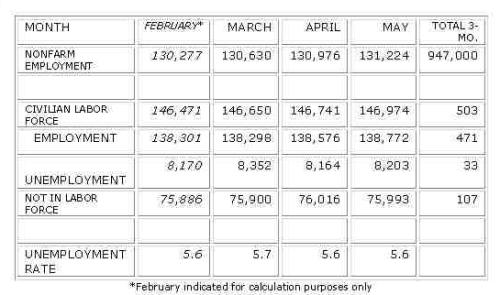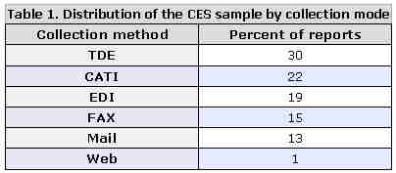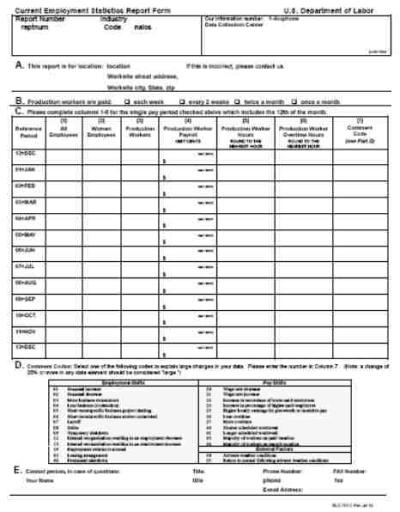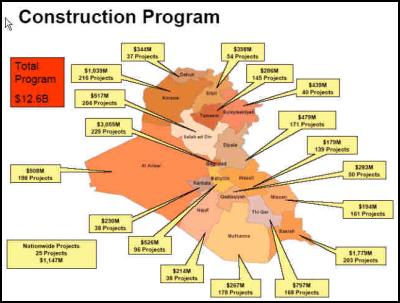Patricia Johnson: Gobs of Jobs II
Gobs of Jobs II
By Patricia Johnson
The bottom line is profit. Each month there are numerous reports published in this country, i.e. Consumer Price Index, Housing Starts, Retail Sales, Help Wanted Index, Wholesale Trade, Factory Orders, Retail Sales, Help Wanted Index, Employment Situation, etc. The list goes on and on as there are roughly 50 monthly economic indicators that investors utilize in adjusting their portfolios.
One of the most significant economic releases is the Employment Situation Report released monthly by the Bureau of Labor Statistics (BLS). This report indicates how many people are working, how many are unemployed, the various industries that are picking up and/or losing jobs, the average workweek and average hourly earnings for production, or non-supervisory workers. A serious investor watches this particular report very closely and reacts accordingly.
The Employment Situation Report for the month of May was released by the BLS at 8:30 a.m. (EDT) on Friday, June 4, 2004. The Dow Jones Industrials opened at 10,196.83 on Friday, June 4, and closed at 10,410.10 on Thursday, June 10 (the market was closed on Friday June 11). So within the week, the DJIA gained more than 200 points based on the positive economic releases.
DATE DJIA OPEN DJIA CLOSE
10-Jun-04 10,367.80 10,410.10
9-Jun-04 10,431.10 10,368.44
8-Jun-04 10,389.41 10,432.52
7-Jun-04 10,243.31 10,391.08
4-Jun-04 10,196.83 10,242.82
Close price adjusted for dividends and splits.
The Employment Situation Summary
for the month of May 2004 is simply incredible. Not only
did non-farm payroll employment rise by 248,000 in May, this
was on top of the 346,000 reported for April, and a revised
figure of 353,000 for the month of March 2004. So, we are
looking at a total of 947,000 new jobs created in the three
month period.

The Employment Situation Report isn’t new. The BLS has been providing statistics since 1915. It’s safe to assume that their methods of calculating the figures have been reviewed time and time again. For details on how each statistic is calculated refer to the online BLS Handbook of Methods (click here) and you’ll see that there is nothing left to chance as far as the computation of statistics.
We already know that the BLS uses two separate groups of statistics when preparing their monthly report. The number of unemployed persons and rate of unemployment is derived from the Current Population Survey (Household Survey), while the increase or decrease in jobs is derived from the Current Employment Statistics survey, CES, (Establishment Survey).
The total of 947,000 new jobs that have been created over the past three months comes from the CES or Establishment Survey. In 2003 approximately 160,000 firms participated in the CES. All firms with 1,000 or more employees are asked to participate in the survey, but participation is voluntary, except in specific states.
There are six variations to the basic CES form, which are tailored to the needs of the following industries:
1. Natural Resources and mining
2. Construction
3. Manufacturing
4. Service-providing industries
5. Public administration
6. Educational services
7.
All respondents are provided with a CES reporting form, except those that report electronically. For those that report by mail, the form is mailed each month, edited by the State agency and then returned to the respondent for use the following month.
The BLS Handbook of Methods indicates that the data is collected as follows:
Sample dataEach month, the State agencies cooperating with BLS, as well as BLS Data Collection Centers, collect data on employment, payrolls, and paid hours from a sample of establishments. Data are collected through various automated collection modes and by mail. Touch-tone data entry (TDE) serves as the primary type of electronic reporting, although a large number of reports are collected via direct electronic file transmission (EDI), and a small but growing number are received via the Internet (Web). Additionally, many respondents report via computer-assisted telephone interviews (CATI) or FAX. Table 1 summarizes the distribution of the CES sample by collection mode.

The BLS statistics
form itself is relatively simple, or is it? We’ll use the
Manufacturing form for our discussion (click
here)

The form only has five sections, A, B, C, D and E, so it should be relatively easy to fill out, if your payroll is computerized and all items coded; otherwise, from an accounting standpoint, it would be something of a nightmare to complete based on the accompanying definitions and instructions for completion.
Let’s assume that all establishments complete their form correctly, all turn in their forms in a timely manner, and all statistics prepared by the BLS are accurate.
Everyone who can write seems to have an opinion on why the numbers are wrong, or how they should be corrected.
One article is suggesting that the jobs reported by the BLS is an imaginary invention of the birth/death modeling statistical method used by the BLS. The writer suggests that over the past four months this method “ padded the total job growth by over 730,000 jobs”. In calendar year 2003 the average birth/death model adjustment was 77,000 per month, while the average birth/death model adjustment for the first five months of calendar year 2004 is 82,000 per month.
The BLS realizes that the birth/death modeling has drawbacks and is working towards an alternative approach as follows:
“The most significant potential drawback to this or any model-based approach is that time series modeling assumes a predictable continuation of historical patterns and relationships and therefore is likely to have some difficulty producing reliable estimates at economic turning points or during periods when there are sudden changes in trend. BLS will continue researching alternative model-based techniques for the net birth/death component; it is likely to remain as the most problematic part of the estimation process.”
Another article questioned the base data used and suggested the statistics should come from FICA tax records. The problem with that theory is there is a ceiling on FICA taxes, currently $87,900. Once an employee earns $87,900 they are not required to pay FICA taxes. Payroll taxes are the same – not all employees pay payroll taxes as some may have so many exemptions that taxes are not withheld by their employers.
The Bureau of Labor Statistics knows that the numbers presented from the various establishments will contain errors. Whenever you have thousands of different people completing a form, there are going to be errors, no matter how well the instructions are presented.
In an effort to adjust for erroneous information the BLS revises the information once a year. The BLS describes this revision as follows: “The benchmark adjustment represents a once-a-year re-anchoring of sample-based employment estimates to full population counts available through unemployment insurance (UI) tax records filed by nearly all employers with State Employment Security Agencies.”
There are some industries that are exempt from mandatory UI coverage, and in those instances the BLS uses additional information obtained from the Census Bureau for benchmark revisions.
The benchmark revision for 2003 that was published on February 6, 2004 (click here) also has some tongues wagging. Over the past ten years benchmark revisions have averaged 0.3 percent, with a range from 0.1 percent to 0.7 percent. At 0.1 percent this revision is not out of the ordinary. The only thing unusual is the benchmark revision is normally made in June, and this revision was made in February, due to the fact that the UI figures were available earlier.
If you look at the information provided by the Household Data survey you’ll see that in February the number of employed persons is indicated as 138,301,000, unemployed of 8,170,000, and an unemployment rate of 5.6%. In May the Household Data is indicating employment of 138,772,000 unemployment of 8,203,000 and an unemployment rate of 5.6%.
So, according to the Household Data survey we have 471,000 more people employed in May than in February, and 33,000 more unemployed.
The last item we’re going to review will be the Unemployment Insurance Weekly Claims Report for the week ending June 5, 2004 (click here)
“In the week ending June 5, the advance figure for seasonally adjusted initial claims was 352,000, an increase of 12,000 from the previous week's revised figure of 340,000. The 4-week moving average was 346,000, an increase of 4,750 from the previous week's revised average of 341,250.”
We know that there were
jobs created because both the Household Data and the
Establishment Data surveys are indicating job creation, but
the Unemployment insurance report is indicating increasing
initial claims for unemployment benefits
as
follows:
DATE CLAIMS
03/06/2004 341,000
03/13/2004 333,000
03/20/2004 344,000
03/27/2004 343,000
04/03/2004 330,000
04/10/2004 362,000
04/17/2004 356,000
04/24/2004 338,000
05/01/2004 318,000
05/08/2004 333,000
05/15/2004 347,000
05/22/2004 345,000
05/29/2004 340,000
06/05/2004 352,000
The average number of seasonally adjusted unemployment claims filed over the last three calendar months has increased each month as follows:
MAR 2004 APR 2004 MAY 2004
340,000/wk 346,000/wk 420,000/wk
While the employment reports are showing job gains, unemployment claims are rising. How can that be?
The BLS may very well have some numbers that need to be tweaked a little, but my guess is the jobs in Iraq are the driving force behind the increased numbers in both the Household data and the Establishment data, based on the following:

Click for big version
Source: Coalition Provisional
Authority
Program Management Office
Pentagon
Backgrounder
David Nash, ADM (Ret), Director
May
24, 2004
Even though the work is being done in Iraq, the majority of contracts were awarded to U.S. companies. We know for a fact that employees of U.S. companies are working in Iraq as six have already been killed.
We know that there are 164 accelerated projects being worked on in Iraq by the project management office, in addition to other ongoing projects (click here)
We know that major contracts, totaling 8.3 billion dollars have already been awarded to American companies for work in Iraq and we know that by June 15, 2004 all contracts for the $12.6 billion dollars will be awarded. The following listing only indicates contracts awarded through March 31, 2004 (click here)
Amount Contractor Location
Up to 1,800,000,000.00 Bechtel National CALIFORNIA
Up to 415,000,000.00 Parsons Iraqi Joint Venture TEXAS
.00 Worley Group Australia
Up to 412,000,000.00 Kellogg Brown & Root VIRGINIA
65,449,155.00 Earth Tech, Inc. CALIFORNIA
31,136,252.00 Parsons Infrastructure CALIFORNIA
75,749,910.00 Shaw Environmental LOUISIANA
16,279,724.00 Weston Solutions PENNSYLVANIA
98,682,431.00 Fluor Intercontinental NORTH CAROLINA
33,078,193.00 Washington International/Black & Veatch
12,705,000.00 CH2MHill/Dragados/Soluziona COLORADO
56,281,864.00 Fluor Intercontinental
51,409,080.00 Kellogg, Brown & Root VIRGINIA
21,610,501.00 AECOM CALIFORNIA
28,494,672.00 CH2MHill COLORADO
.00 Parsons Water Infrastructure, Inc. CALIFORNIA
8,458,350.00 Louis Berger Group, Inc. D.C. – USA
.00 URS Group, Inc. CALIFORNIA
8,458,350.00 Louis Berger Group, Inc. D.C. – USA
.00 URS Group, Inc. CALIFORNIA
10,754,664.00 Louis Berger Group, Inc. D.C. – USA
.00 URS. Group, Inc. CALIFORNIA
43,361,340.00 Iraq Power Alliance Joint Venture
Iraq Parsons Energy and Chemical Group PENNSYLVANIA
.00 Parsons-Brinckerhoff, Ltd. United Kingdom
8,416,985.00 Foster Wheeler, Co. United Kingdom
Up to 600,000,000.00 Washington International/Black & Veatch Joint Venture IDAHO
Up to 500,000,000.00 Fluor AMEC, LLC SOUTH CAROLINA
.00 Fluor CALIFORNIA
.00 AMEC United Kingdom
Up to 500,000,000.00 Washington International, Inc. NEW JERSEY
Up to 500,000,000.00 Perini Corporation MASSACHUSETTS
Up to 600,000,000.00 Fluor AMEC SOUTH CAROLINA
.00 Fluor CALIFORNIA
.00 AMEC United Kingdom
Up to 500,000,000.00 Fluor AMEC SOUTH CAROLINA
.00 Fluor CALIFORNIA
.00 AMEC UNITED KINGDOM
Up to 325,000,000.00 Contrack/AICI/OCI/Archirodon Joint Venture VIRGINIA
.00 Contrack D.C. UNITED STATES
.00 AICI MARYLAND
.00 OCI EGYPT
.00 Archirodon Joint Venture Netherlands
Panama
United Arab Emirates
Up to 75,000,000.00 Lucent Technologies World Services NEW JERSEY
Up To 500,000,000.00 Parsons Delaware, Inc. CALIFORNIA
Up to 900,000,000.00 Parsons Delaware, Inc. CALIFORNIA
19,536,683.00 Laguna Construction Co., Inc. NEW MEXICO
70,000,000.00 NANA Pacific ALASKA
$8,286,863,154.00
TOTAL
The following link (click here) will take you to an additional 65 pages of contracts awarded by the CPA for Iraq. These contracts do not indicate names, but do show dollar amounts and contract numbers.
Bottom line – the jobs may not be here, but the profits are.


 Binoy Kampmark: Fallibility, Dirty Wars And Pope Francis I
Binoy Kampmark: Fallibility, Dirty Wars And Pope Francis I Peter Dunne: Dunne's Weekly - An Issue No-one Can Afford To Lose
Peter Dunne: Dunne's Weekly - An Issue No-one Can Afford To Lose Martin LeFevre - Meditations: Choosing Mass Murder?
Martin LeFevre - Meditations: Choosing Mass Murder? Eugene Doyle: Quiet Mutiny - The U.S. Army Falls Apart
Eugene Doyle: Quiet Mutiny - The U.S. Army Falls Apart Gordon Campbell: Papal Picks, And India As A Defence Ally
Gordon Campbell: Papal Picks, And India As A Defence Ally Binoy Kampmark: The Selling Of America - Ending The US Dollar’s Exorbitant Privilege
Binoy Kampmark: The Selling Of America - Ending The US Dollar’s Exorbitant Privilege